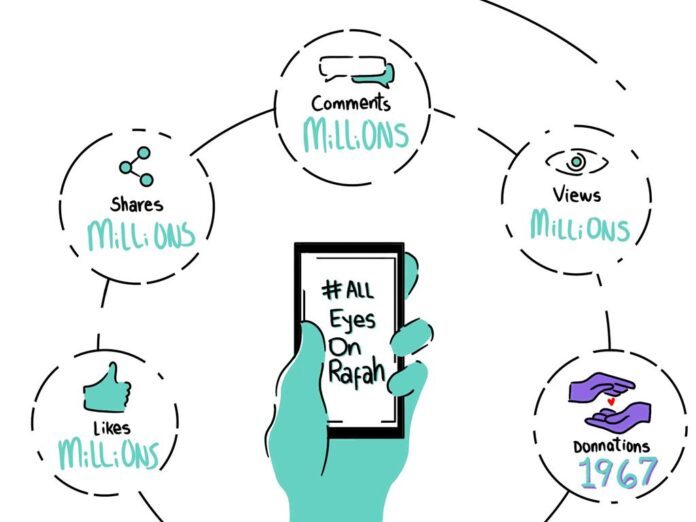On May 26, 2024, Israeli forces fired on a displacement camp and designated “safe area” in Al-Mawasi, killing at least 45 people. Israeli Prime Minister Benjamin Netanyahu deemed the air strike a “tragic mistake.”
The mistaken attack on displaced Palestinian civilians in Rafah sparked the online trend “All eyes on Rafah,” which has since been shared over 50 million times on Meta platforms Instagram and Facebook. The convenient “add yours” sticker allows users to promptly add the AI-generated image to their story.
As I pawed through story after story sharing the same image, it all seemed too easy, and a little eerie, bringing back memories of the black squares that dominated our feeds in the wake of the murder of George Floyd in 2020. #AlleyesonRafah is the latest “slacktivism” trend. Did we not learn anything from “#BlackoutTuesday”?
#BlackoutTuesday showed us that not all activism counts. The act of protesting was accomplished after a quick share of a black square, a photo of literally nothing, with a mass generated hashtag that actually drowned out the voices of those sharing vital information about the Black Lives Matter (BLM) movement. Today, many do not know why they participated in BLM — just that it was the thing to do at the time. Slacktivists wear participation as a badge of “woke” honour, but having open and critical conversations around race relations in the West continues to be divisive and in some cases, banned in schools.
While there are many rising concerns with AI and AI-generated images, #AlleyesonRafah is particularly reductive. Sanitizing and dehumanizing the daily horrors that Palestinians face with the cartoonish image is a dilution of their reality. Journalists on the ground in Gaza are risking their lives to report on a region that has been actively suppressed for decades by mainstream Western media outlets.
The popularity of #AlleyesonRafah moved the State of Israel’s Instagram account to share a story of an AI-generated image in response: a Hamas militant standing over a baby with the phrase “Where were your eyes on October 7?” Which was “mistakenly” removed by Meta, before being reposted. Now, numerous AI-generated images flood social platforms as Meta limits political content.
While evidence suggests that those who heavily participate in online activism are more likely to also participate offline, I can’t help but feel dejected when seeing mass viral social movements. Maybe AI-generation is the way around political censorship, but it does not substitute intentional action and self-education.
Here’s some things you can do to support Palestianians, instead of resharing the AI-generated images and other posts like it.
Join, support, or aid student protests calling for universities to divest from businesses that support Israel. UBC students have maintained their encampment of MacInnes Field, which began on April 29. Nationally, similar encampments calling for divestment have taken place at McMasters, McGill, and U of T.
Amplify the voices of journalists and activists. I suggest following Bisan Owda, a filmmaker sharing real-time content on the situation in Gaza, as a place to start.
Donate to charities on the ground. For Rafah, donate a minimum of $10 CAD to Glia, an organization bringing supplies and medical aid to one of the last standing hospitals in Gaza, Al-Aqsa.
Kiara Okonkwo is a writer and creative. She received a diploma in Screenwriting from Vancouver Film School and is pursuing her Bachelor of Fine Arts in Creative Writing and Media and Communication Studies. Kiara values self-expression and authenticity.


